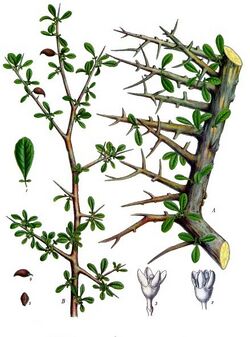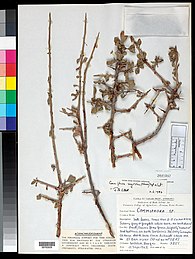Biology:Commiphora myrrha
| Commiphora myrrha | |
|---|---|

| |
| Scientific classification | |
| Kingdom: | Plantae |
| Clade: | Tracheophytes |
| Clade: | Angiosperms |
| Clade: | Eudicots |
| Clade: | Rosids |
| Order: | Sapindales |
| Family: | Burseraceae |
| Genus: | Commiphora |
| Species: | C. myrrha
|
| Binomial name | |
| Commiphora myrrha (Nees) Engl.[1]
| |
| Synonyms[2] | |
|
List
| |
Commiphora myrrha, called myrrh,[1] African myrrh,[1] herabol myrrh,[1] Somali myrrhor,[1] common myrrh,[3] is a tree in the Burseraceae family. It is one of the primary trees used in the production of myrrh, a resin made from dried tree sap. The tree is native to the Arabian peninsula (Oman, Yemen) and to Africa (Djibouti, Ethiopia, Somalia, Northeast Kenya).[4] It is called 'mur' (المر) in Arabic, meaning bitter. It famously comes from Mecca, so it is called 'Mur Makki'.[citation needed]
Description
Commiphora myrrha is very spiny and it grows to a height of about 5 m (16 ft).[5] Its short, hairless, thick, and flaky trunk has two layers of bark. The upper layer is silvery, whitish, reddish, or bluish-grey and has a papery-texture. Underneath it, the bark is green and performs photosynthesis.
Due to this species' high variability, Commiphora myrrha can be difficult to distinguish from other species within the Commiphora genus.[6] The leaves of Commiphora myrrha are a greyish-green colour with a papery texture.[5] The plant's leaves may come in an oblong or oval shape and are between 6-44mm long, and 3-20mm wide.[5][7] Each leaf alternates and consists of three leaflets in a pinnately compound arrangement.[5]
The plant's yellow-red flowers are dioecious and are arranged in a panicle inflorescence.[5][7] The flowers of the common myrrh are very tiny and are oval shaped. The male flowers are only 3-4mm long and flower early. Its smooth, brown fruit is about the same size as the flowers, and is shaped like an egg.
Resin
From the stem of Commiphora myrrha, its oleoresin oozes from incisions in the bark and dries into small clumps of sap.[8][9] The resin's fragrance and its medicinal properties come from the various classes of terpenoids it contains.[10] Additionally, the common myrrh tastes sour, bitter, and aromatic.
Distribution and habitat
Native to eastern and northeastern Africa and the Arabian peninsula, this plant grows on slopes and valleys in desert regions with open Vachellia.[6][7][8] It grows at an elevation of approximately 250 to 1,300 m (820 to 4,270 ft) with a yearly mean rainfall of about 23 to 30 cm (9.1 to 11.8 in). It does best in thin soil, primarily in areas with limestone.[11]
History
Myrrh extracted from Commiphora myrrha was a precious commodity in the ancient world, as it was used to create perfumes and incense.[8] Myrrh was traditionally used in the ancient world as an insect repellent, incense for religious rituals and in embalming the dead.[7][8] Physicians also took advantage of its medicinal properties, treating it for several ailments, including wounds, diseases such as leprosy and syphilis, and to help with digestion and menstruation.
Medicinal properties
It is anti-bacterial, anti-fungal, anti-pest and can be used for fumigation or oral use.[10] It has been used as an astringent, antiseptic, anti-parasitic, anti-viral anti-tussive, emmenagogue, and anti-spasmodic agent. It was commonly included in mixtures used to treat worms, wounds, and sepsis. It is also a potent treatment for gingivitis, canker sores, sore throat, boils, arthritis, and acne.[12] Due to its medicinal properties, it is imagined as a potential preventative and therapeutic agent for several diseases, including COVID-19.[10]
Modern uses
Resin from Commiphora myrrha continues to be an important source of myrrh, which is a key ingredient that adds flavour to meat products, desserts, soft drinks, gum, and sweets.[6] Moreover, its use as a fragrance in incense has extended to other cosmetic products, such as mouthwash,[7] soaps, and perfumes.
References
- ↑ 1.0 1.1 1.2 1.3 1.4 {{citation | mode = cs1 | title = Commiphora myrrha | work = Germplasm Resources Information Network (GRIN) | url = | publisher = [[Organization:Agricultural Research ServAgricultural Research Service (ARS), United States Department of Agriculture (USDA) | access-date = 2009-01-15 }}
- ↑ "Commiphora myrrha". The Plant List: A Working List of All Plant Species. http://www.theplantlist.org/tpl1.1/record/kew-2733595.
- ↑ Mixing Essential Oils for Magic: Aromatic Alchemy for Personal Blends. Llewellyn Worldwide. 8 November 2013. pp. 191–. ISBN 978-0-7387-3715-7. https://books.google.com/books?id=oeINAQAAQBAJ&pg=PA191.
- ↑ "Commiphora myrrha". Cactus art: The world of cacti & succulents. http://www.cactus-art.biz/schede/COMMIPHORA/Commiphora_myrrha/Commiphora_myrrha/Commiphora_myrrha.htm.
- ↑ 5.0 5.1 5.2 5.3 5.4 "Commiphora myrrha". https://www.cactus-art.biz/schede/COMMIPHORA/Commiphora_myrrha/Commiphora_myrrha/Commiphora_myrrha.htm.
- ↑ 6.0 6.1 6.2 "Myrrh - American Botanical Council". https://www.herbalgram.org/resources/herbalgram/issues/93/table-of-contents/herbalgram-93-herb-profile-myrrh/.
- ↑ 7.0 7.1 7.2 7.3 7.4 "Commiphora myrrha Myrrh, Myrrh Gum PFAF Plant Database". https://pfaf.org/user/Plant.aspx?LatinName=Commiphora+myrrha.
- ↑ 8.0 8.1 8.2 8.3 "Commiphora myrrha". https://www.cactus-art.biz/schede/COMMIPHORA/Commiphora_myrrha/Commiphora_myrrha/Commiphora_myrrha.htm.
- ↑ "Myrrh - American Botanical Council". https://www.herbalgram.org/resources/herbalgram/issues/93/table-of-contents/herbalgram-93-herb-profile-myrrh/.
- ↑ 10.0 10.1 10.2 "Commiphora myrrh: a phytochemical and pharmacological update". Naunyn-Schmiedeberg's Archives of Pharmacology 396 (3): 405–420. November 2022. doi:10.1007/s00210-022-02325-0. PMID 36399185.
- ↑ "Commiphora myrrha Species Information". World of Forestry Centre. http://www.worldagroforestrycentre.org/sea/products/afdbases/af/asp/SpeciesInfo.asp?SpID=17990.
- ↑ El Ashry, E. S. H.; Rashed, N.; Salama, O. M.; Saleh, A. (2003-03-01). "Components, therapeutic value and uses of myrrh". Die Pharmazie 58 (3): 163–168. PMID 12685809. https://www.ingentaconnect.com/content/govi/pharmaz/2003/00000058/00000003/art00001#expand/collapse.
External links
- "List of Chemicals Found in Commiphora myrrha". Dr. Duke's Phytochemical and Ethnobotanical Databases. U.S. Department of Agriculture. https://phytochem.nal.usda.gov/phytochem/plants/show/515.
- Committee on Herbal Medicinal Products. "Myrrha". European Medicines Agency. https://www.ema.europa.eu/en/medicines/herbal/myrrha.
Wikidata ☰ Q164609 entry
 |



